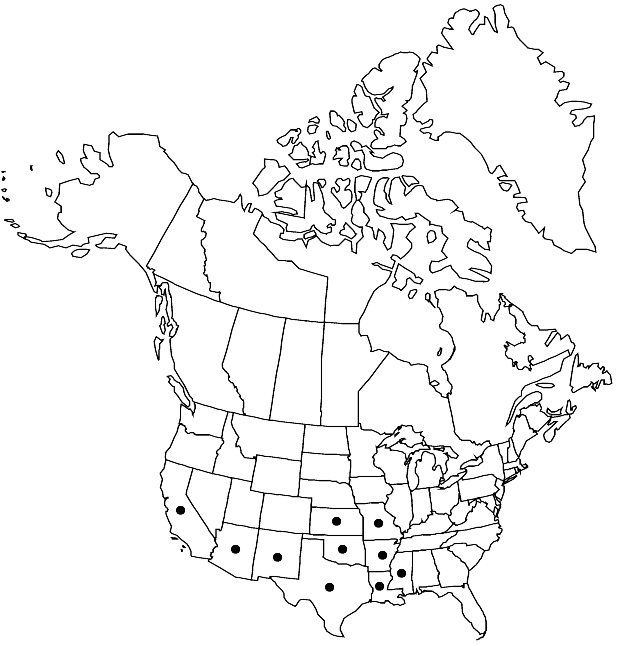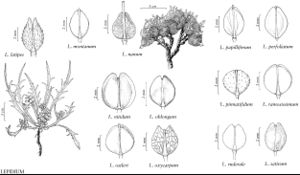Lepidium oblongum
Fl. S.E. U.S., 468, 1331. 1903.
Annuals; hirsute (trichomes cylindrical). Stems often several from base, erect to ascending or decumbent, branched distally, (5–) 1–2.4 (–3.2) dm. Basal leaves not rosulate; petiole (0.5–) 1–3 cm; blade 1-pinnatifid or 2-pinnatifid, 0.7–3.5 cm, margins (of lobes) entire or dentate. Cauline leaves usually sessile, rarely shortly petiolate; blade obovate to oblanceolate (in outline), 0.8–2 cm × 2–9 mm, base cuneate, auriculate or not, margins dentate to laciniate or pinnatifid. Racemes elongated in fruit; rachis hirsute, trichomes mostly straight, cylindrical. Fruiting pedicels divaricate to horizontal, usually slightly recurved, rarely straight, (terete), 2–3.5 (–5) × 0.2–0.3 mm, puberulent adaxially or, rarely, throughout. Flowers: sepals (tardily deciduous to somewhat persistent), ovate to broadly oblong, 0.7–1 × 0.4–0.6 mm; petals (absent or rudimentary), white, linear-oblanceolate, 0.1–0.7 × 0.05–0.15 mm, claw absent; stamens 2, median; filaments 0.7–1 mm; anthers 0.15–0.2 mm. Fruits orbicular to broadly obovate or elliptic, 2.2–3.5 × 2–3 mm, apically winged, apical notch 0.2–0.3 mm deep; valves thin, smooth, not veined, glabrous or sparsely puberulent (along margin); style to 0.1 mm, included in apical notch. Seeds ovate, 1.2–1.6 × 0.7–1 mm.
Phenology: Flowering Mar–Aug.
Habitat: Prairies, pastures, floodplains, waste grounds, llanos, disturbed areas, roadsides, flats, calcareous sand, alluvial terraces
Elevation: 0-1200 m
Distribution

Ariz., Ark., Calif., Kans., La., Miss., Mo., N.Mex., Okla., Tex., Mexico (Baja California), Mexico (Coahuila), Mexico (Hidalgo), Mexico (Nuevo León), Mexico (Puebla), Mexico (San Luis Potosí), Mexico (Tamascaltepec), Mexico (Veracruz), Central America (El Salvador), Central America (Guatemala)
Discussion
Hitchcock distinguished var. insulare from var. oblongum on the basis of having fruits smaller (2–2.5 versus 2.5–3 mm) and rotund to obovate (versus elliptic or obovate-elliptic) and fruiting pedicels puberulent (versus glabrous) abaxially. The shape and size of fruits almost never covary, and some of the insular plants (e.g., Trask 28, GH) have the largest fruits; some populations from Arizona, Oklahoma, and Texas have smaller and perfectly orbicular fruits. As for the pubescence of fruiting pedicels, some of the inland plants cited by Hitchcock as L. oblongum (e.g., Brewer 27, GH) have pedicels pubescent abaxially.
A recent report of Lepidium bonariense naturalized in Skagit County, Washington, was based on misidentified L. oblongum; all the vouchers for it belong to the latter species. Lepidium oblongum often has several stems from base, usually auriculate distalmost leaves, and fruits 2–3 mm wide. By contrast, L. bonariense has single stems from base, non-auriculate distalmost leaves, and fruits 2.7–3.5 mm wide.
Selected References
None.
Lower Taxa
"elongated" is not a number."thick" is not a number."dm" is not declared as a valid unit of measurement for this property."dm" is not declared as a valid unit of measurement for this property.
